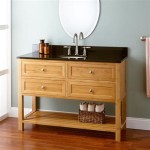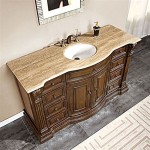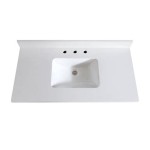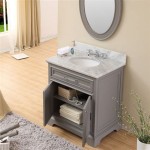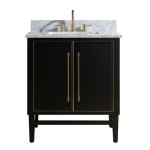24 Inch Bathroom Vanity Cabinet: A Comprehensive Guide
The 24-inch bathroom vanity cabinet is a common fixture in residential bathrooms, providing both storage and a surface for the sink and countertop. Its compact size makes it suitable for smaller bathrooms, powder rooms, or renovation projects where space is a primary constraint. This article will delve into the various aspects of a 24-inch bathroom vanity cabinet, including its dimensions, materials, styles, installation considerations, and maintenance.
Understanding the Dimensions and Space Considerations
The nominal size of a 24-inch bathroom vanity cabinet refers to its width. However, the actual dimensions can vary slightly depending on the manufacturer and the specific design. Generally, a 24-inch vanity will measure approximately 24 inches in width, 18-22 inches in depth, and 30-36 inches in height. These dimensions are crucial to consider when planning a bathroom renovation or new construction project.
Before purchasing a 24-inch vanity, it is essential to accurately measure the available space in the bathroom. This includes the width, depth, and height of the area where the vanity will be installed. Account for any obstructions, such as plumbing fixtures, pipes, or architectural features. Furthermore, consider the swing radius of the bathroom door and ensure that the vanity placement does not impede access to other fixtures, such as the toilet or shower.
Beyond the vanity's physical footprint, consider the surrounding space required for comfortable use. This includes enough room to stand comfortably in front of the sink, open drawers and doors without obstruction, and access the plumbing connections for maintenance or repairs. A clearance of at least 30 inches between the front of the vanity and any opposing wall or fixture is generally recommended.
When selecting a 24-inch vanity, it is crucial to consider the height of the countertop and sink. Standard vanity heights range from 30 to 36 inches. Taller individuals may prefer a higher vanity for increased comfort, while shorter individuals may find a lower vanity more suitable. The height of the sink basin also factors into the overall comfort level. Consider a vessel sink mounted on top of the countertop, which will add to the overall height. Alternatively, an undermount sink will maintain a lower profile.
Material Selection and Style Variations
Bathroom vanities are available in a wide range of materials, each with its own distinct properties and aesthetic appeal. The choice of material will significantly impact the vanity's durability, moisture resistance, and overall appearance.
Solid wood, such as oak, maple, or cherry, is a popular choice for bathroom vanities due to its natural beauty and durability. Solid wood vanities are generally more expensive than those made from other materials but offer a premium look and feel. They can be stained or painted to match a variety of bathroom decors. However, solid wood is susceptible to moisture damage and requires proper sealing and maintenance.
Plywood is an engineered wood product made from layers of wood veneer glued together. It is more dimensionally stable than solid wood and less prone to warping or cracking in humid environments. Plywood is often used for the cabinet box and other structural components of the vanity. It can be finished with a wood veneer, laminate, or paint.
Medium-density fiberboard (MDF) is another engineered wood product made from wood fibers and resin. It is a dense, smooth material that is ideal for painting or applying a laminate finish. MDF is less expensive than solid wood or plywood but is also more susceptible to water damage. It is best suited for use in well-ventilated bathrooms with minimal exposure to moisture.
Laminate is a synthetic material made from layers of plastic and paper bonded together. It is a durable, water-resistant material that is easy to clean and maintain. Laminate vanities are available in a wide range of colors and patterns, including wood-grain finishes. They are a cost-effective option for budget-conscious homeowners.
Beyond the materials, the style of the vanity can greatly influence the overall aesthetic of the bathroom. Traditional vanities often feature raised panel doors, decorative moldings, and ornate hardware. They are available in a variety of wood finishes, such as cherry, oak, and maple.
Modern vanities tend to have clean lines, minimalist designs, and sleek hardware. They are often finished in white, gray, or black, and may feature flat-panel doors or open shelving. Modern vanities often incorporate contemporary materials, such as glass, metal, and concrete.
Transitional vanities blend elements of traditional and modern styles. They may feature simple shaker-style doors, a neutral color palette, and a mix of traditional and contemporary hardware. Transitional vanities offer a versatile option that can complement a variety of bathroom decors.
Installation, Plumbing, and Countertop Considerations
Installing a 24-inch bathroom vanity cabinet typically involves connecting the plumbing, securing the cabinet to the wall, and installing the countertop and sink. Proper planning and preparation are essential for a successful installation.
Before starting the installation, turn off the water supply to the bathroom. Disconnect the existing plumbing fixtures, including the water supply lines and drainpipe. Remove the old vanity and clean the area where the new vanity will be installed.
Carefully position the new vanity in the desired location. Use a level to ensure that it is perfectly level both horizontally and vertically. If necessary, use shims to adjust the height and level of the vanity.
Once the vanity is level, secure it to the wall studs using screws. Ensure that the screws are long enough to penetrate the studs and provide adequate support. If the wall studs are not properly aligned, use wall anchors to provide additional support.
Connect the water supply lines to the faucet using flexible supply hoses. Ensure that the connections are tight and leak-free. Connect the drainpipe to the sink drain using a P-trap. The P-trap is designed to prevent sewer gases from entering the bathroom.
The countertop is a critical component of the bathroom vanity, providing a durable and attractive surface for the sink and personal care items. Common countertop materials include granite, marble, quartz, and solid surface materials.
Granite is a natural stone that is highly durable and resistant to heat, scratches, and stains. It is available in a wide range of colors and patterns, making it a popular choice for bathroom countertops. However, granite is porous and requires periodic sealing to prevent staining.
Marble is another natural stone that is prized for its beauty and elegance. It is softer than granite and more susceptible to scratches and stains. Marble is often used in high-end bathrooms and requires careful maintenance.
Quartz is an engineered stone made from crushed quartz and resin. It is highly durable, non-porous, and resistant to scratches, stains, and heat. Quartz countertops are available in a wide range of colors and patterns and require minimal maintenance.
Solid surface materials, such as Corian and Swanstone, are synthetic materials made from acrylic or polyester resins. They are non-porous, easy to clean, and can be seamlessly integrated with the sink. Solid surface countertops are available in a wide range of colors and patterns and are a popular choice for bathroom vanities.
When selecting a countertop for a 24-inch vanity, it is crucial to consider the size and shape of the sink. Common sink types include undermount, vessel, and drop-in sinks. Undermount sinks are installed beneath the countertop, creating a seamless look. Vessel sinks sit on top of the countertop, adding height and visual interest. Drop-in sinks are installed into a cutout in the countertop, with a rim that sits flush with the surface.
After the vanity and countertop are installed, inspect all plumbing connections for leaks. Turn on the water supply and check for any drips or seepage. If necessary, tighten the connections or replace any faulty parts.

Bathroom Vanity 24 Inch Small Bath With Sink Modern Cabi Overstock

24 Inch Bathroom Vanity Terra Bemma

Home Decorators Collection Ridge 24 In W X 22 D 34 H Bath Vanity Cabinet Without Top White Rg24 Wh The

Modern Luxury Floating Bathroom Cabinet Storage Basin Set 24 Inch Melamine Wood Vanity With Sink Led Mirror Medicine Made In China Com

24 Floating Bathroom Vanity With Sink Wood Cabinet Small Set White Green Gray And Blue Inch Etsy

Home Decorators Collection Winsome 24 In Bath Vanity Cabinet Without Top Sand Ws24 Sd The

1919 24 Bathroom Vanity Cabinet Set

Ravenna 24 Single Sink Bathroom Vanity Combo Set 2 Drawers Shelf Cabinet White Engineered Marble Top And Ceramic Vessel

Uforic 24 Inch Bathroom Vanity With Countertop Sink Combo Modern Storage Cabinet Drain White And Gold Wal Com

24 Inch Bathroom Vanity With Sink For Small Space Modern Design Wall Mounted Cabinet Set Resin Basin Top Plywood Melamine Sanitary Ware Made In China Com
